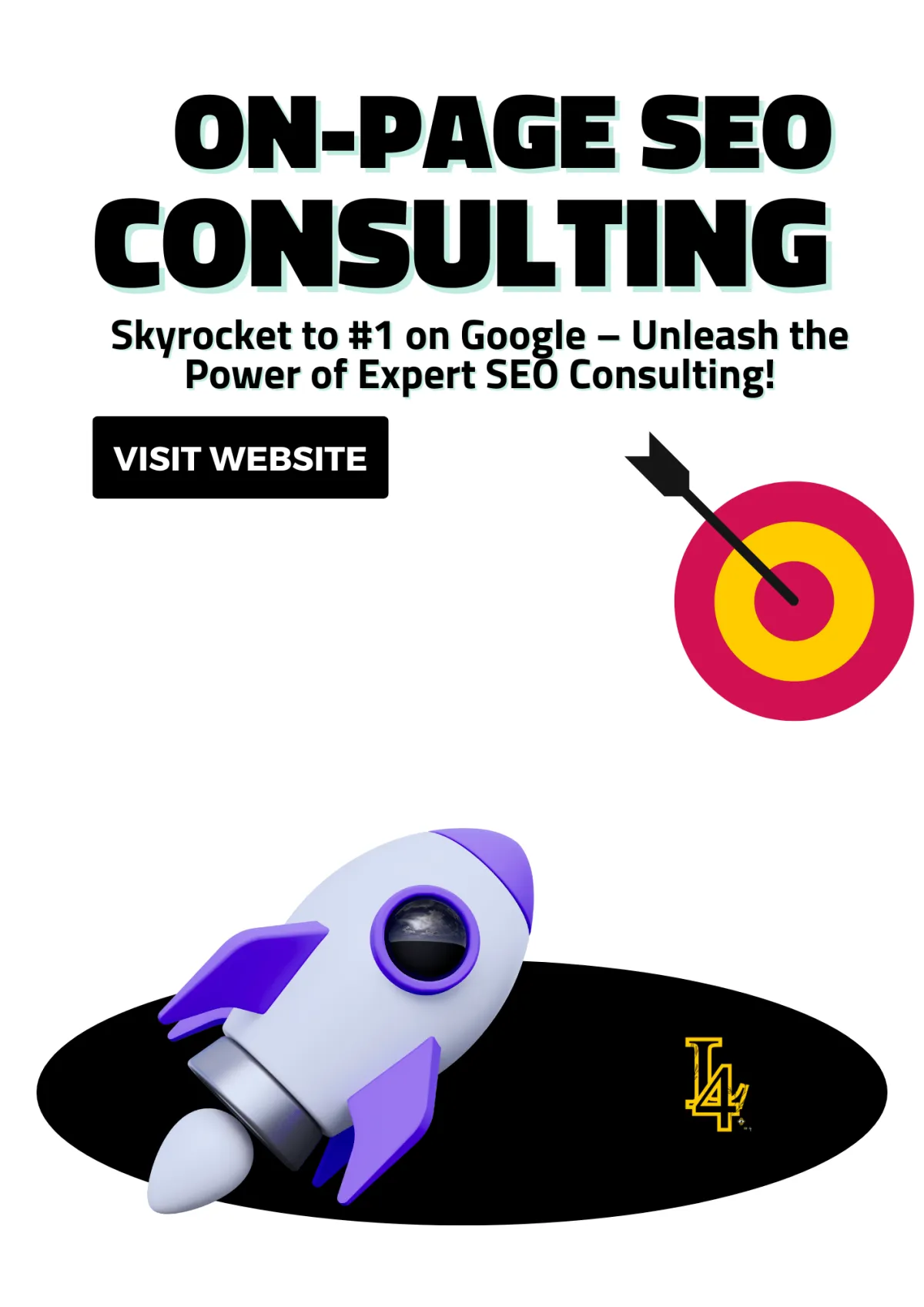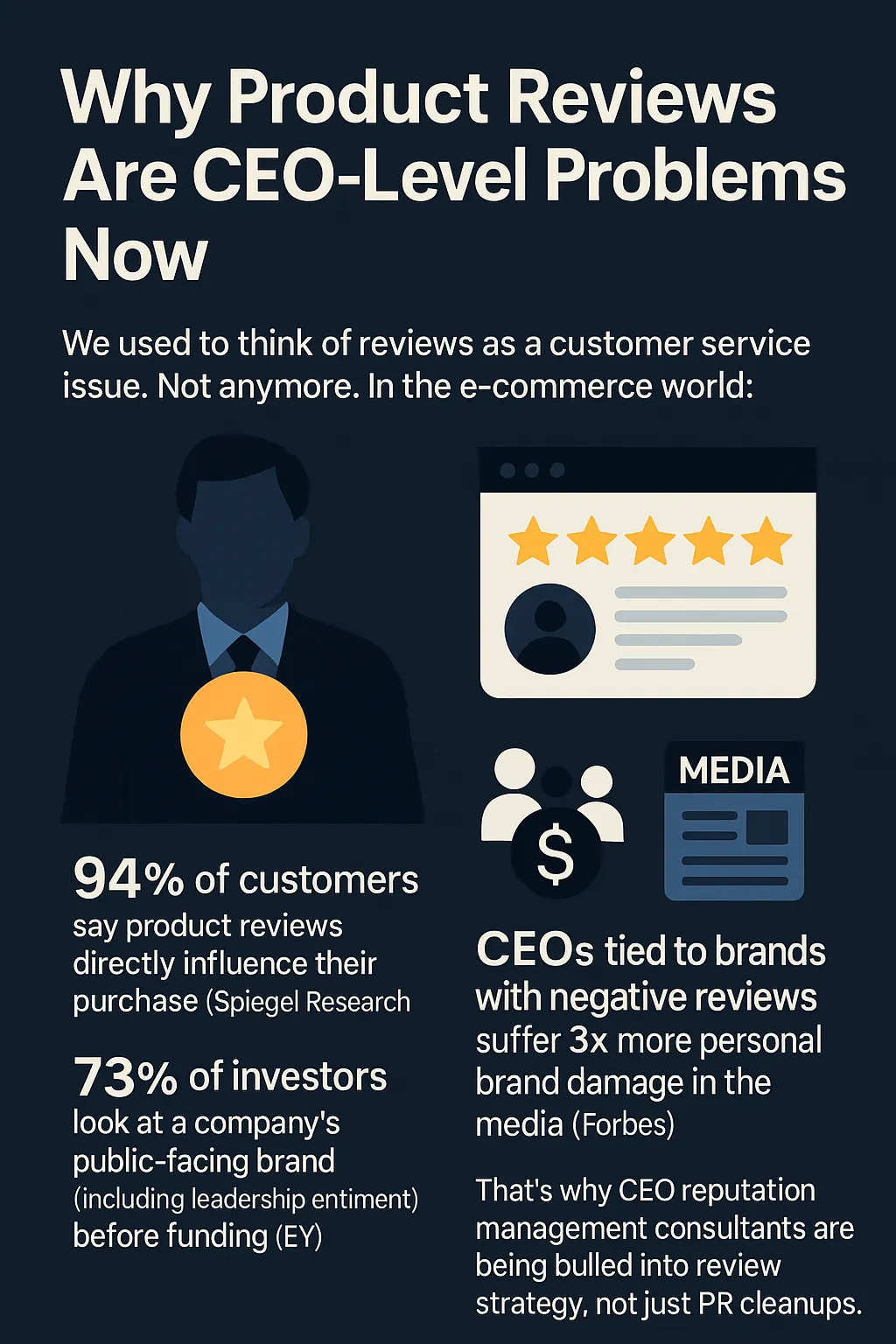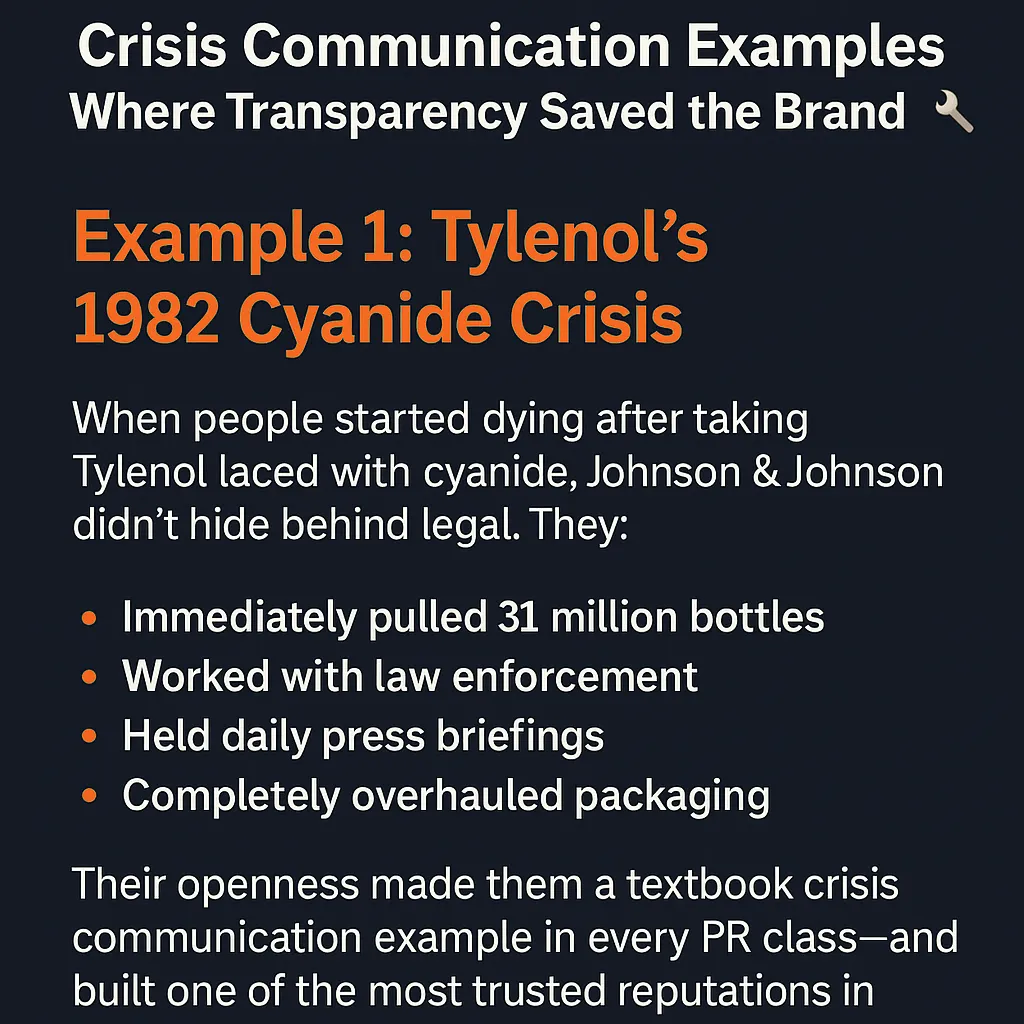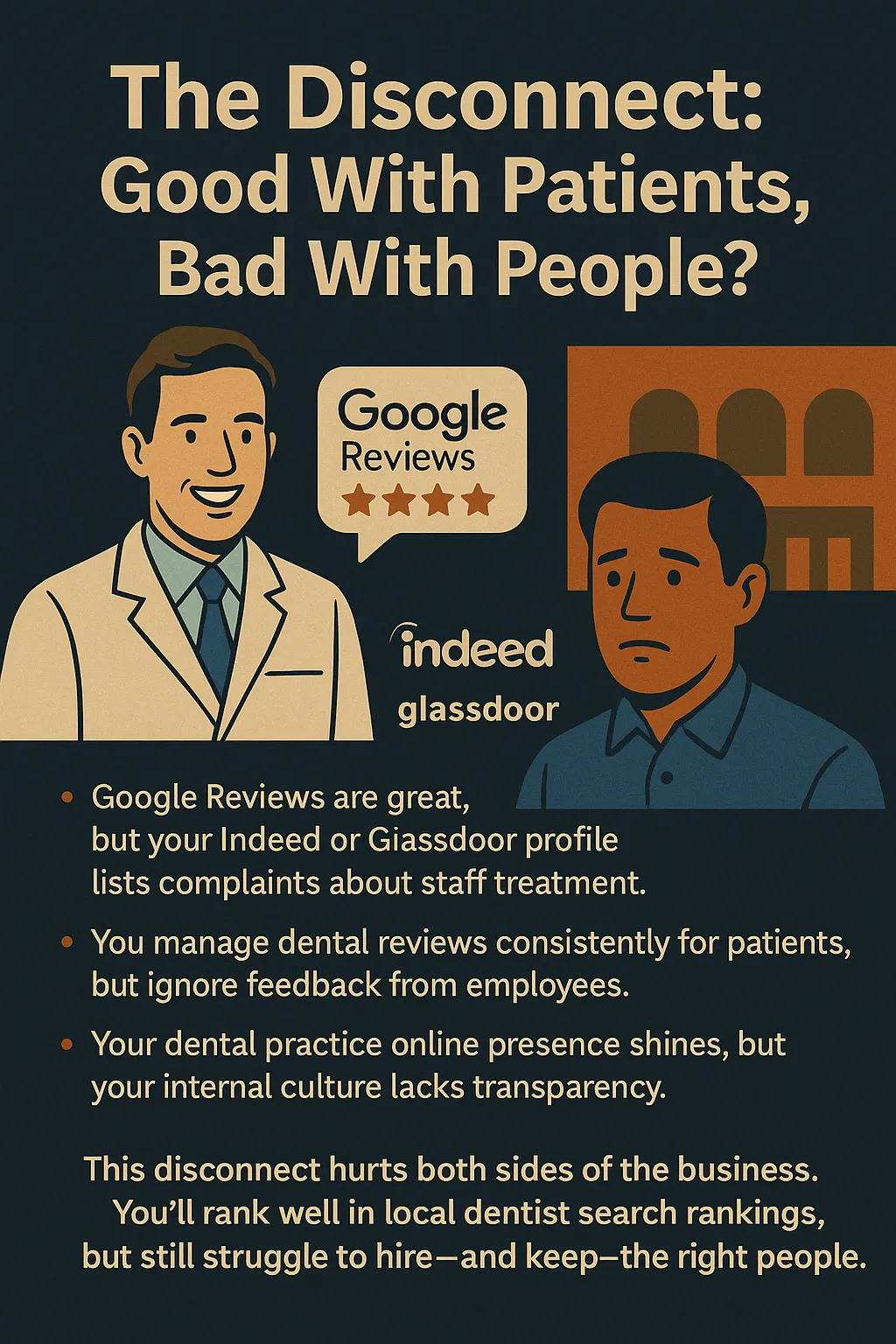
Transparent by Design: Modern Reputation Strategy Powered by Crisis Communication
Transparent by Design: Modern Reputation Strategy Powered by Crisis Communication
Why Transparency Has Become the Cornerstone of Crisis Response
Here’s why transparency matters:
Crisis Communication Examples Where Transparency Saved the Brand
🔧 Example 1: Tylenol’s 1982 Cyanide Crisis
🚗 Example 2: Domino’s Pizza Video Scandal
☁️ Example 3: Buffer’s Security Breach
🚫 Where Brands Fail: Crisis Communication Examples to Avoid
❌ United Airlines: The Passenger Dragging Scandal
❌ Facebook and the Cambridge Analytica Data Scandal
The Bigger Problem: A Crisis Without a Strategy
What These Examples Should Teach Every Business
How I Coach Brands to Use Transparency Strategically
1. Pre-Write Transparent Response Templates
2. Train Spokespeople to Be Real, Not Robotic
3. Create a Public Accountability Loop
What Transparency Looks Like in 2025
Final Word: Transparency Is Not Weakness—It’s Reputation Power
I’ve spent years helping brands navigate firestorms—and if there’s one thing I’ve learned, it’s this: transparency isn’t a buzzword. It’s a strategy. A necessity. A reputation lifeline.
In today’s landscape, a tight-lipped response to a crisis will destroy trust faster than the crisis itself. And nothing proves this more than looking at real crisis communication examples—the wins, the fails, and the brands that turned radical honesty into a powerful reputation advantage.
Let me show you exactly how transparency fuels modern reputation strategy—and why hiding behind PR-speak is now a guaranteed way to lose.

Why Transparency Has Become the Cornerstone of Crisis Response
People are skeptical. They’ve seen too many brands issue vague statements, dodge accountability, or blame “unforeseen circumstances.” So when a brand actually steps up, tells the truth, and shows what they’re doing about it, it cuts through the noise.
Here’s why transparency matters:
63% of consumers say they’ll buy from a brand they trust—even after a mistake (Edelman Trust Barometer)
85% believe honesty is the most important trait in a brand during a crisis (PwC)
Transparent brands recover 30% faster from PR setbacks (Forrester)
You don’t just need a response. You need truth—and the courage to share it. Let’s look at crisis communication examples that nailed it.
Crisis Communication Examples Where Transparency Saved the Brand

🔧 Example 1: Tylenol’s 1982 Cyanide Crisis
When people started dying after taking Tylenol laced with cyanide, Johnson & Johnson didn’t hide behind legal. They:
Immediately pulled 31 million bottles
Worked with law enforcement
Held daily press briefings
Completely overhauled packaging
Their openness made them a textbook crisis communication example in every PR class—and built one of the most trusted reputations in healthcare.
🚗 Example 2: Domino’s Pizza Video Scandal
In 2009, two employees uploaded a disgusting prank video. Instead of ducking it, Domino’s:
Released a CEO video apology within 48 hours
Fired the employees and filed criminal charges
Shared their process overhaul publicly
This level of honesty turned a viral nightmare into a redemption arc—and Domino’s became one of the fastest-growing chains post-crisis.
☁️ Example 3: Buffer’s Security Breach
When Buffer was hacked in 2013, they:
Emailed all users immediately
Posted live updates every few hours
Explained exactly what happened and what they fixed
Took responsibility without spin
It’s one of my favorite modern crisis communication examples—because it proved transparency = trust, especially in tech.

🚫 Where Brands Fail: Crisis Communication Examples to Avoid
Not all brands emerge from a crisis with their integrity intact. In fact, some fail so badly that their missteps become textbook crisis communication examples—but for all the wrong reasons. These failures reveal what happens when companies lack a clear transparency reputation strategy and fail to prioritize honest, timely, and strategic communication.
Let’s look at some of the most notorious breakdowns in crisis communication—and what they teach us about the non-negotiable role of transparency in brand reputation today.
❌ United Airlines: The Passenger Dragging Scandal
This is one of the most widely cited crisis communication examples in modern history. A paying passenger was violently dragged from an overbooked flight, and United Airlines’ initial response lacked any form of empathy or accountability. Instead of owning the moment, they issued a robotic statement that described the incident as a passenger being “re-accommodated.”
The damage to their brand reputation strategy was immediate and global. The public outcry was fierce, employee morale took a hit, and United’s stock price dropped overnight.
Transparency in reputation strategy was missing entirely. No direct apology. No clear action plan. No humanity in their communication. This crisis could have been contained with real-time updates, clear accountability, and a willingness to acknowledge fault. Instead, it became a viral masterclass in what not to do.
❌ Facebook and the Cambridge Analytica Data Scandal
This is another classic crisis communication failure. When Facebook’s user data was exploited by Cambridge Analytica, the company waited too long to respond. When they finally did, their messages were vague, overly technical, and laced with legal disclaimers instead of genuine concern.
The absence of transparency in their communication strategy deepened public mistrust. Their delayed and evasive messaging turned what could have been a contained issue into a long-lasting brand crisis that continues to haunt their corporate image today.
This situation is one of the clearest crisis communication examples where a lack of honesty, timing, and clarity turned a PR problem into an existential threat to the brand. Facebook’s response lacked emotional intelligence, transparency, and alignment with stakeholder expectations—all foundational elements of an effective reputation management strategy.
The Bigger Problem: A Crisis Without a Strategy
These cases aren’t isolated—they’re warnings. When companies skip the basics of transparency in crisis communication, they lose public trust, market value, and long-term credibility.
Here's what these crisis communication examples have in common:
No immediate acknowledgment of the issue
Delayed responses that allowed the narrative to spiral
Statements written to protect legal liability rather than express genuine care
A failure to align with their own reputation strategy or brand values
Little to no proactive engagement with media or affected audiences
These aren’t just communication flaws—they’re signs of a broken or nonexistent crisis communication plan. Without transparency and an actionable, pre-planned reputation strategy, brands are left reacting instead of leading.
What These Examples Should Teach Every Business
Modern audiences don’t want perfection—they want transparency. They want to know that when things go wrong, the brand will own it, fix it, and communicate with clarity and consistency.
Every failed example above reinforces a key truth: your crisis communication strategy is only as strong as your commitment to transparency. Whether you're a tech giant, an airline, or a small business, the ability to communicate clearly and empathetically in times of crisis is what defines your reputation in the long run.
So if you’re building or revisiting your own reputation management framework, ask yourself:
Does our strategy prioritize real-time transparency?
Are our leaders trained in emotionally intelligent messaging?
Do we have examples of how not to respond—and do we learn from them?
The smartest brands study failed crisis communication examples not to criticize—but to build systems that make sure they never repeat them.

How I Coach Brands to Use Transparency Strategically
When I help brands build crisis playbooks, transparency is built into every layer. Here’s how we do it:
1. Pre-Write Transparent Response Templates
We don’t just draft neutral press statements. We prepare:
“We were wrong” responses
“Here’s what we’re doing now” updates
“We hear you and here’s what changed” follow-ups
This helps us avoid panic-mode PR writing under pressure.
2. Train Spokespeople to Be Real, Not Robotic
I run mock crisis sessions where we train out the corporate tone and train in clarity, empathy, and ownership.
3. Create a Public Accountability Loop
We don’t stop at one statement. We update stakeholders weekly (or daily, if needed) until trust is rebuilt. Real-world crisis communication examples prove that repeated, honest communication wins long-term loyalty.

What Transparency Looks Like in 2025
Transparency isn’t just saying, “We made a mistake.”
It’s:
Showing behind-the-scenes decision-making
Explaining why the mistake happened
Publishing audit results, process changes, and metrics
Giving customers and employees a seat at the table
If you don’t lead with this kind of openness, your silence will be filled by tweets, reviews, blogs, and leaks. Crisis communication examples show us: when you don't control your story, someone else will.
Final Word: Transparency Is Not Weakness—It’s Reputation Power
A brand that’s honest about failure is more trustworthy than one that pretends to be flawless. I’ve helped companies bounce back from devastating crises—because they were willing to tell the truth when it counted.
You don’t avoid PR fallout by being perfect. You avoid it by being real.
If your reputation strategy doesn’t include transparency by default, you’re not future-proof. You’re one viral moment away from losing everything.
✅ Want a Transparency-Driven Crisis Plan?
Today’s consumers expect more than polished branding—they expect truth, speed, and empathy. Brands that embrace transparency don’t just survive crises—they earn lasting trust. If your organization isn’t ready to communicate clearly under pressure, you’re leaving your reputation to chance.
I work with companies to build crisis plans rooted in real-world transparency, not generic PR spin. Here's how:
🔍 Audit and Revise Crisis Protocols
We assess your existing crisis communication framework to identify gaps and inconsistencies. Using guidelines from leading authorities like the Institute for Public Relations and Ready.gov, we align your response playbook with best practices.
✍️ Write Honest, Audience-First Response Playbooks
Your crisis messaging must speak to real people—not legal teams. We craft response templates grounded in behavioral science and audience expectations. This ensures your brand responds with clarity, empathy, and authority.
🗣️ Train Teams on Transparent Messaging Under Pressure
Your frontline team is your brand's voice in a crisis. I deliver live and virtual training on transparent communication techniques, modeled after strategies from organizations like the CDC’s Crisis & Emergency Risk Communication (CERC) program.
📊 Benchmark Transparency with Real Crisis Communication Examples
We don’t guess—we study. From the Tylenol recall case to Buffer’s security breach response, we review powerful crisis communication examples to help your team see what works (and what doesn’t) in the real world.
Whether you're preparing for the unexpected or recovering from recent fallout, I help brands shift from reactive to resilient. Transparency is not just a value—it’s a strategy.
Let’s make sure your brand is known for honesty—especially when it matters most.
Want a personalized consultation or a crisis-readiness audit? Contact me here to get started.
Web Design Articles
Turn Clicks to Cash: Build a Web Template That’s Straight Heat
Master the Art of Web Page Outlines: Your Blueprint for a High-Performing Website
8 Must-Have Features for the Perfect Video Website Template (Make Your Videos Stand Out!)
SEO Articles
Get 10X More Leads Overnight! The SEO Lead Generation Blueprint That Works
SEO Startup Success: How to Build a Profitable SEO Company & Land High-Paying Clients!
The Ultimate Guide to Internal Linking: Boost Website Traffic and User Experience
Marketing Articles
Best Ideas for Free Local Advertising for Small Businesses
How to Add the Title to a Link (The Right Way) – Boost SEO & UX!














